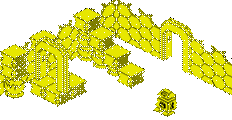Sinclair ZX81
Vital Statistics
Introduced
March 1981 |
|
![]()
Work on the ZX81 hardware began in September 1979, even before the launch of the ZX80, but it was the development of the uncommitted logic array, or ULA, which allowed the machine to go into production. The task of upgrading the ZX80's hardware at Sinclair Research fell to their chief engineer, Jim Westwood. This task was primarily to reduce the number of components (and hence, cost) and also to fix some of the most annoying problems of the earlier machine. Jim and his team discovered they could reduce component count by combining 18 of the ZX80s chips into a single uncommitted logic array (ULA) chip. The ULA, produced by Ferranti for Sinclair, reduced the chip count as required, and brought the retail cost of the machine, in kit-form, down to £49.95. As with the ZX80, Nine Tiles was called upon to provide the new BASIC, but this time there was double the ROM space (now 8K) to play with. John Grant did the core hardware interface coding, and Steve Vickers, who had joined Nine Tiles in January 1980 added the floating-point arithmetic, including trigonometric and other functions. Grant came up with one of the ZX81's more novel features, a syntax checker that indicated errors in BASIC code as soon as it was entered (rather than, as was standard at the time, only disclosing coding errors when a program was run. "As far as Clive was concerned, it wasn't a question of what the machine ought to be able to do, but more what could be crammed into the machine given the component budget he'd set his mind on," said Vickers in an interview on July 23, 1985. "The only firm brief for the '81 was that the '80's math package must be improved." The ROM was almost complete by the end of autumn 1980, but support still had to be added for the ZX Printer. Somewhere between this time and the launch, a bug crept in which caused the square root of 0.25 to be 1.3591409. Nine Tiles quickly fixed the bug, but Sinclair was somewhat tardy in making this version available to people who had already bought the machine - they had to send out replacement computers in such cases! The Sinclair ZX81 replaced the ZX80 in February 1981. This new machine now provided SLOW and FAST mode, which meant the ZX81 was capable of executing a program and writing to the screen at the same time (SLOW mode). The ZX80 only had FAST mode which could not do this. The 4K ROM included 30 new functions plus some new instructions to control a printer. Because of better componentisation, the ZX81 was able to be sold for £30 less than the outgoing ZX80. Production of the ZX81 started at a small electronics manufacturer based in St Ives, Cambridgeshire, but soon after the product went on sale it became apparent they would not be able to cope with the demand in orders. In light of this, Clive Sinclair went into partnership with Timex Corporation who were struggling financially in the face of the wave of digital watches competing with their analogue products. This wasn't natural for Timex to produce electronic circuits, but their director, Fred Olsen, made the decision they need to diversify into new markets to survive. Hence, most ZX81s ended up being manufactured in Dundee, Scotland by Timex Corporation, at the company's Dryburgh factory. Marketing the new ZX81 was the responsibility of Sinclair's long-standing marketing partner, Primary Contact. Given this task, they had a major challenge – how to market a product simultaneously at hobbyists and at the "man on the street", who probably had little or no computer literacy. The answer was to pursue what the journalist David O'Reilly of MicroScope magazine described as a single-minded "user-friendly strategy." Chris Fawkes, one of Primary Contact's directors, explained: "We brought personal computers to the mass market by showing that you didn't have to be a whizzkid to use one."Clive Sinclair put it in a 1982 interview with Your Computer,
The ZX81 was well received and became a massive success, spawning a series of clones, both illegal and licensed by Timex, which was manufacturing the UK models for Sinclair at its Dundee plant. Inspired by the public reaction to the ZX81, and annoyed at not winning the contract to design a computer for the British Broadcasting Corporation, Sinclair decided the market needed a budget colour computer. The ZX80 and ZX81 hardware had been the primarily the work of one man; Jim Westwood, but he had been moved to the flat-screen television department, so the hardware design job on the machine which became the ZX Spectrum, was given to Richard Altwasser, while at Nine Tiles, Vickers was again asked to provide the BASIC for the Spectrum. The US version of the ZX81 was marketed by Timex-Sinclair, called the TS1000. This varied only slightly, with 2K RAM instead of 1K, a shielded case, TV output on channels 3 or 4, and the screen was black on light blue background, instead of a white background.
Upgrades and RepairsThere are a few things you can do to improve your ZX81, helping it be part of 21st-century living...
|
ZX81 News05 March 2019Today in 1981: the Sinclair ZX81 Issue One was released
18 March 2018Roust! ZX81 Birthday Edition by Allan Turvey
06 March 201810 PRINT "ZX81 at 37" 20 GOTO 10
|
This page was last updated on 22nd April 2014.














